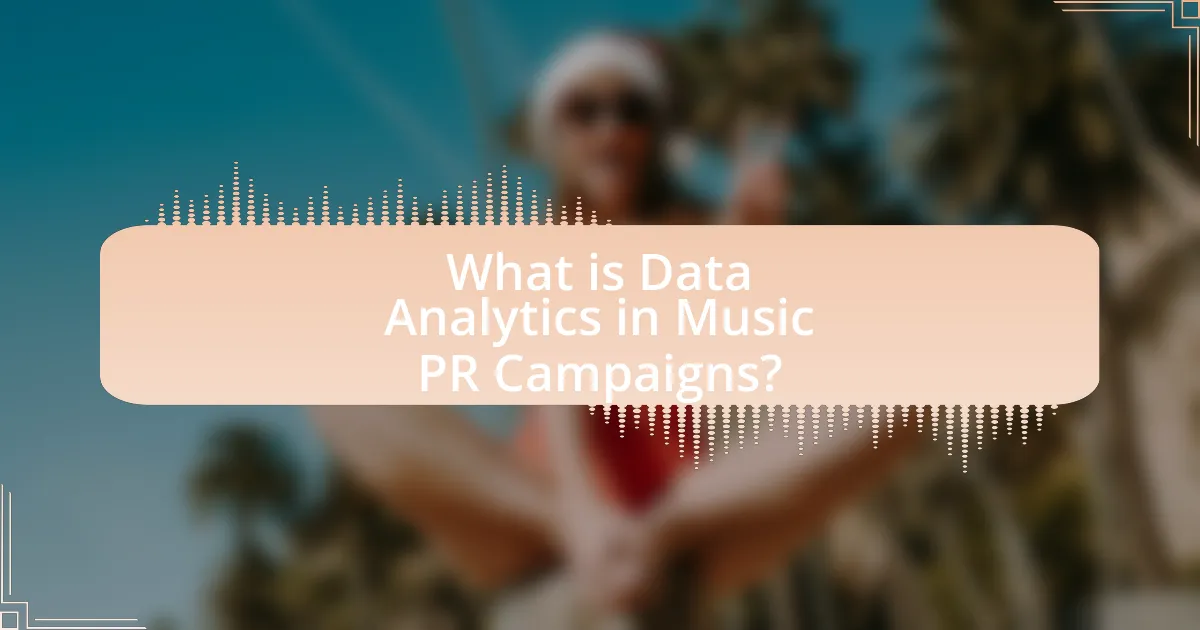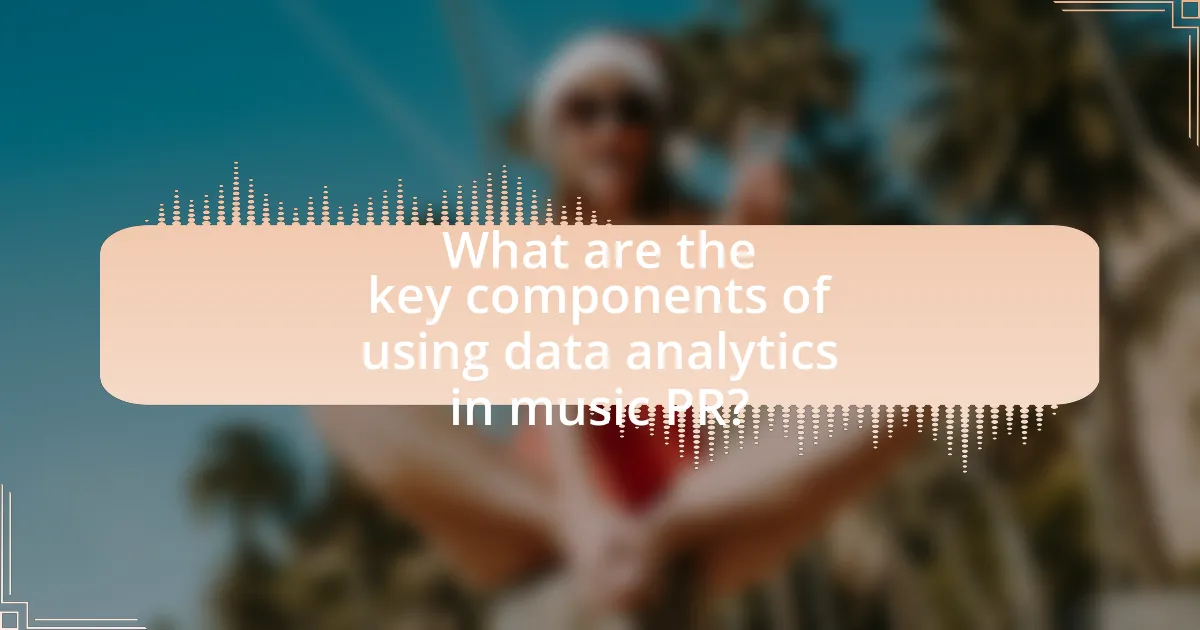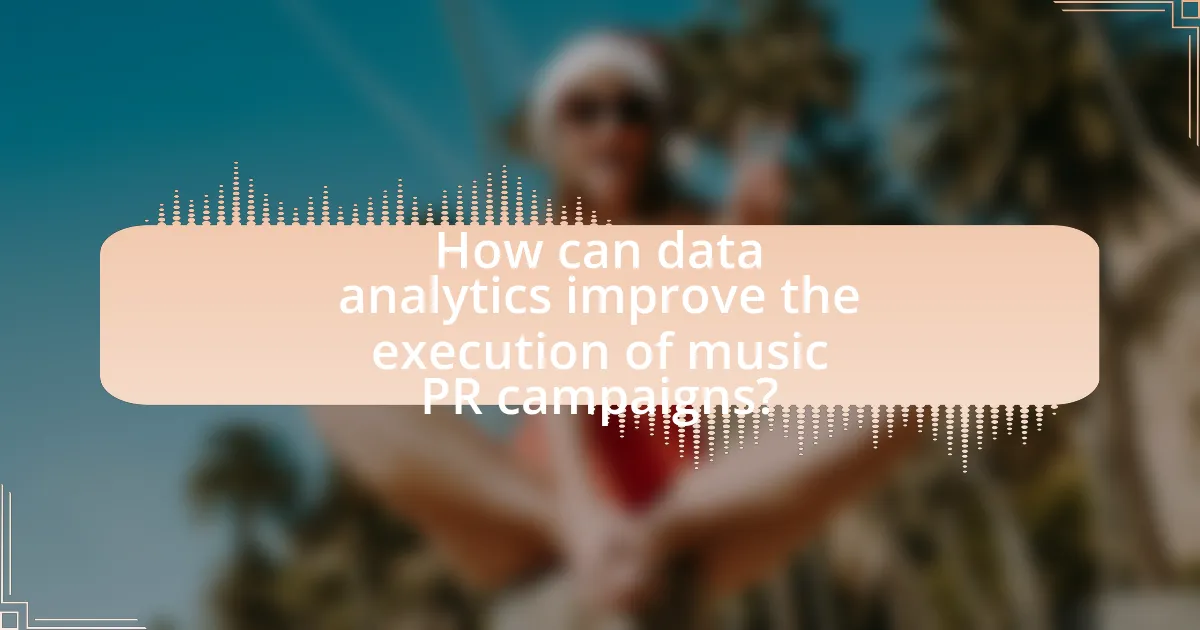Data analytics plays a crucial role in optimizing music PR campaigns by systematically analyzing audience engagement, media coverage, and campaign performance. The article outlines how data-driven strategies enhance PR effectiveness through targeted audience identification, performance tracking, and sentiment analysis. Key components discussed include relevant data types, the importance of real-time insights, and best practices for implementing analytics, such as A/B testing and monitoring key performance indicators (KPIs). Additionally, the article addresses common challenges in data interpretation and privacy concerns, providing practical tips for leveraging analytics to improve campaign outcomes in the music industry.

What is Data Analytics in Music PR Campaigns?
Data analytics in music PR campaigns refers to the systematic analysis of data related to audience engagement, media coverage, and campaign performance to optimize promotional strategies. This process involves collecting metrics from various platforms, such as social media interactions, streaming statistics, and press mentions, to assess the effectiveness of PR efforts. For instance, a study by Nielsen Music found that campaigns leveraging data analytics can increase audience reach by up to 30%, demonstrating the tangible benefits of informed decision-making in music promotion.
How does data analytics enhance music PR strategies?
Data analytics enhances music PR strategies by providing insights into audience behavior and preferences, enabling targeted campaigns. By analyzing streaming data, social media interactions, and demographic information, music PR professionals can identify trends and tailor their messaging to resonate with specific listener segments. For instance, a study by Nielsen Music found that targeted marketing based on listener data can increase engagement rates by up to 30%. This data-driven approach allows for more effective allocation of resources and maximizes the impact of promotional efforts, ultimately leading to increased visibility and success for artists.
What types of data are most relevant for music PR campaigns?
The types of data most relevant for music PR campaigns include audience demographics, engagement metrics, media coverage analysis, and social media insights. Audience demographics provide information on age, gender, location, and interests, which help tailor campaigns to specific groups. Engagement metrics, such as streaming numbers, downloads, and concert attendance, indicate how well the music resonates with listeners. Media coverage analysis tracks mentions in press outlets and blogs, revealing the effectiveness of outreach efforts. Social media insights, including likes, shares, and comments, offer real-time feedback on audience reactions and preferences. Collectively, these data types enable music PR professionals to create targeted and effective campaigns.
How can data analytics inform target audience identification?
Data analytics can inform target audience identification by analyzing consumer behavior, preferences, and demographics through data collection methods such as surveys, social media interactions, and streaming statistics. This analysis enables music PR campaigns to pinpoint specific audience segments that are most likely to engage with the artist or music genre, thereby optimizing marketing strategies. For instance, a study by Nielsen Music found that 70% of listeners prefer personalized music recommendations, highlighting the importance of targeted outreach based on data insights. By leveraging these analytics, music PR professionals can tailor their messaging and promotional efforts to resonate with identified audience segments, ultimately enhancing campaign effectiveness.
Why is data-driven decision-making important in music PR?
Data-driven decision-making is important in music PR because it enables professionals to make informed choices that enhance campaign effectiveness. By analyzing metrics such as audience engagement, streaming statistics, and social media interactions, PR teams can identify trends and tailor their strategies to target specific demographics. For instance, a study by Nielsen Music found that data analytics can increase campaign ROI by up to 30% when used to refine marketing approaches. This reliance on concrete data ensures that resources are allocated efficiently, maximizing the impact of promotional efforts in a competitive industry.
What advantages does data-driven decision-making provide?
Data-driven decision-making provides enhanced accuracy and effectiveness in strategic planning. By utilizing data analytics, organizations can identify trends, measure performance, and make informed choices that align with audience preferences. For instance, a study by McKinsey found that companies leveraging data-driven strategies are 23 times more likely to acquire customers, 6 times more likely to retain customers, and 19 times more likely to be profitable. This demonstrates that data-driven approaches lead to improved outcomes in various business contexts, including music PR campaigns.
How does it impact campaign effectiveness and ROI?
Data analytics significantly enhances campaign effectiveness and ROI by enabling targeted decision-making and optimizing resource allocation. By analyzing audience behavior and engagement metrics, campaigns can be tailored to specific demographics, leading to higher conversion rates. For instance, a study by Nielsen found that data-driven marketing can lead to a 5-8 times increase in ROI compared to traditional methods. This precision in targeting not only improves engagement but also reduces wasted expenditure on ineffective strategies, ultimately maximizing the return on investment for music PR campaigns.

What are the key components of using data analytics in music PR?
The key components of using data analytics in music PR include audience segmentation, performance tracking, and sentiment analysis. Audience segmentation allows PR professionals to identify and target specific demographics, enhancing campaign effectiveness. Performance tracking involves analyzing metrics such as engagement rates and reach to assess the success of promotional efforts. Sentiment analysis evaluates public perception and feedback, enabling adjustments to strategies based on audience reactions. These components collectively inform decision-making and optimize PR campaigns in the music industry.
How can social media analytics be utilized in music PR campaigns?
Social media analytics can be utilized in music PR campaigns by tracking audience engagement, sentiment, and demographic data to tailor marketing strategies effectively. By analyzing metrics such as likes, shares, comments, and follower growth, music PR professionals can identify which content resonates most with their target audience. For instance, a study by Nielsen Music found that 56% of music fans discover new artists through social media, highlighting the importance of targeted content. Additionally, sentiment analysis can reveal public perception of an artist or campaign, allowing PR teams to adjust messaging in real-time. This data-driven approach enhances campaign effectiveness and maximizes reach within specific demographics.
What metrics should be tracked on social media platforms?
The metrics that should be tracked on social media platforms include engagement rate, reach, impressions, follower growth, and conversion rate. Engagement rate measures the level of interaction (likes, comments, shares) relative to the number of followers, indicating how well content resonates with the audience. Reach refers to the total number of unique users who see a post, while impressions count how many times a post is displayed, regardless of clicks. Follower growth tracks the increase or decrease in followers over time, reflecting the effectiveness of outreach efforts. Conversion rate measures the percentage of users who take a desired action, such as clicking a link or signing up for a newsletter, demonstrating the impact of social media campaigns on business goals. These metrics provide essential insights for optimizing music PR campaigns and enhancing audience engagement.
How can engagement data influence PR strategies?
Engagement data can significantly influence PR strategies by providing insights into audience preferences and behaviors. By analyzing metrics such as social media interactions, website traffic, and content shares, PR professionals can tailor their messaging and outreach efforts to resonate more effectively with target demographics. For instance, a study by HubSpot found that companies utilizing data-driven strategies experienced a 30% increase in engagement rates. This demonstrates that leveraging engagement data allows PR teams to refine their campaigns, optimize content distribution, and ultimately enhance their overall effectiveness in reaching and engaging audiences.
What role does audience segmentation play in music PR?
Audience segmentation plays a crucial role in music PR by allowing professionals to tailor their marketing strategies to specific groups of listeners. This targeted approach enhances engagement and increases the effectiveness of promotional efforts. For instance, by analyzing demographic data, music PR teams can identify distinct audience segments based on age, location, and musical preferences, enabling them to craft personalized messages that resonate with each group. Research indicates that targeted marketing can lead to a 20% increase in campaign effectiveness, demonstrating the tangible benefits of audience segmentation in reaching and influencing potential fans.
How can data analytics help in creating audience personas?
Data analytics can significantly enhance the creation of audience personas by providing insights into demographic, behavioral, and psychographic data. By analyzing data from various sources such as social media, website traffic, and customer surveys, marketers can identify patterns and trends that reveal the characteristics and preferences of their target audience. For instance, a study by HubSpot found that companies using data-driven personas saw a 10% increase in conversion rates, demonstrating the effectiveness of leveraging analytics for audience segmentation. This data-driven approach allows for more accurate and tailored marketing strategies, ultimately leading to improved engagement and campaign success in music PR.
What tools are available for audience segmentation analysis?
Tools available for audience segmentation analysis include Google Analytics, Facebook Audience Insights, and HubSpot. Google Analytics provides demographic and behavioral data, allowing marketers to segment audiences based on website interactions. Facebook Audience Insights offers detailed information about users on the platform, enabling targeted advertising based on interests and behaviors. HubSpot combines CRM data with analytics to create segmented lists for personalized marketing campaigns. These tools are widely used in data analytics for effective audience targeting in music PR campaigns.

How can data analytics improve the execution of music PR campaigns?
Data analytics can significantly enhance the execution of music PR campaigns by providing actionable insights into audience behavior and preferences. By analyzing data from social media interactions, streaming platforms, and audience demographics, PR professionals can tailor their strategies to target specific segments more effectively. For instance, a study by Nielsen Music found that campaigns leveraging data analytics saw a 30% increase in engagement rates compared to those that did not utilize such insights. This data-driven approach allows for more precise messaging, optimized timing for releases, and improved allocation of marketing resources, ultimately leading to higher visibility and success for music artists.
What are the best practices for implementing data analytics in campaigns?
The best practices for implementing data analytics in campaigns include defining clear objectives, selecting relevant metrics, utilizing appropriate tools, and continuously analyzing and optimizing performance. Clear objectives guide the analytics process, ensuring that data collection aligns with campaign goals. Relevant metrics, such as engagement rates and conversion rates, provide insights into campaign effectiveness. Utilizing tools like Google Analytics or social media analytics platforms enables efficient data collection and analysis. Continuous analysis allows for real-time adjustments, enhancing campaign performance based on data-driven insights. These practices are supported by studies indicating that data-driven campaigns can lead to a 5-10% increase in ROI, demonstrating the effectiveness of strategic analytics implementation.
How can A/B testing be used to refine PR messages?
A/B testing can be used to refine PR messages by comparing two variations of a message to determine which one resonates better with the target audience. This method allows PR professionals to analyze metrics such as engagement rates, click-through rates, and audience feedback for each version. For instance, a study by HubSpot found that A/B testing can increase conversion rates by up to 49%, demonstrating its effectiveness in optimizing communication strategies. By systematically testing different headlines, content formats, or calls to action, PR teams can make data-driven decisions that enhance the impact of their messaging in music PR campaigns.
What role does real-time data play in campaign adjustments?
Real-time data is crucial for making timely adjustments in campaign strategies. It enables marketers to monitor performance metrics instantly, allowing for immediate responses to audience engagement, trends, and feedback. For instance, a study by McKinsey & Company found that companies leveraging real-time analytics can improve their marketing effectiveness by up to 20%. This immediate insight helps in optimizing content, reallocating budgets, and refining targeting strategies, ensuring that campaigns remain relevant and effective throughout their duration.
How can data analytics measure the success of music PR campaigns?
Data analytics can measure the success of music PR campaigns by tracking key performance indicators (KPIs) such as media coverage, audience engagement, and social media metrics. By analyzing the volume and sentiment of press mentions, PR professionals can assess the reach and impact of their campaigns. For instance, a study by the Public Relations Society of America found that campaigns with measurable objectives and analytics saw a 30% increase in effectiveness. Additionally, metrics like website traffic, streaming numbers, and social media interactions provide concrete data on audience response, allowing for a comprehensive evaluation of campaign success.
What key performance indicators (KPIs) should be monitored?
Key performance indicators (KPIs) that should be monitored in music PR campaigns include media coverage, social media engagement, audience reach, and conversion rates. Media coverage tracks the number of articles, reviews, and features published about the artist or campaign, providing insight into visibility. Social media engagement measures likes, shares, comments, and follower growth, indicating audience interaction and interest. Audience reach assesses the total number of individuals exposed to the campaign, which is crucial for understanding overall impact. Conversion rates evaluate the percentage of audience actions taken, such as streaming music or purchasing tickets, reflecting the effectiveness of the campaign in driving desired outcomes. Monitoring these KPIs allows for data-driven adjustments to enhance campaign performance.
How can post-campaign analysis inform future strategies?
Post-campaign analysis can inform future strategies by providing insights into what elements of a campaign were successful and which were not. By examining metrics such as engagement rates, audience demographics, and conversion statistics, marketers can identify patterns and trends that indicate effective tactics. For instance, a study by HubSpot found that campaigns with detailed post-analysis saw a 30% increase in effectiveness in subsequent efforts. This data-driven approach allows for the refinement of messaging, targeting, and overall strategy, ensuring that future campaigns are more aligned with audience preferences and behaviors.
What are some common challenges in using data analytics for music PR?
Common challenges in using data analytics for music PR include data integration, data quality, and interpreting results. Data integration is often difficult due to the variety of sources, such as social media, streaming platforms, and traditional media, which can lead to fragmented insights. Data quality issues arise when the information collected is incomplete or inaccurate, affecting the reliability of the analysis. Additionally, interpreting results can be complex, as music PR professionals may struggle to translate data into actionable strategies, particularly when faced with ambiguous metrics or rapidly changing trends in audience behavior. These challenges can hinder effective decision-making and campaign optimization in the music PR landscape.
How can data privacy concerns affect data collection?
Data privacy concerns can significantly limit data collection by imposing restrictions on how personal information is gathered, stored, and utilized. Regulations such as the General Data Protection Regulation (GDPR) in Europe mandate explicit consent from individuals before their data can be collected, which can reduce the volume of available data for analysis. Additionally, heightened awareness of privacy issues may lead individuals to opt out of data sharing, further constraining the data pool. Research indicates that 79% of consumers express concerns about how their data is used, which can deter organizations from collecting data without clear privacy measures in place.
What strategies can be employed to overcome data interpretation issues?
To overcome data interpretation issues in music PR campaigns, employing strategies such as standardization of data formats, utilizing data visualization tools, and conducting regular training sessions for team members is essential. Standardization ensures consistency in data collection and interpretation, reducing discrepancies. Data visualization tools, like Tableau or Google Data Studio, help in presenting complex data in an understandable manner, facilitating better insights. Regular training sessions enhance team members’ analytical skills, enabling them to interpret data accurately and make informed decisions. These strategies collectively improve the reliability of data interpretation, leading to more effective PR campaign outcomes.
What practical tips can enhance the use of data analytics in music PR campaigns?
Utilizing data analytics effectively in music PR campaigns can be enhanced by implementing targeted audience segmentation, leveraging social media insights, and measuring campaign performance through key performance indicators (KPIs). Targeted audience segmentation allows PR professionals to tailor messages to specific demographics, increasing engagement rates; for instance, a study by Nielsen Music found that targeted marketing can boost listener engagement by up to 30%. Leveraging social media insights helps identify trends and audience preferences, enabling PR teams to craft relevant content that resonates with fans. Additionally, measuring campaign performance through KPIs such as reach, engagement, and conversion rates provides concrete data to assess the effectiveness of strategies, allowing for real-time adjustments. This data-driven approach ensures that music PR campaigns are not only creative but also strategically aligned with audience behaviors and preferences.